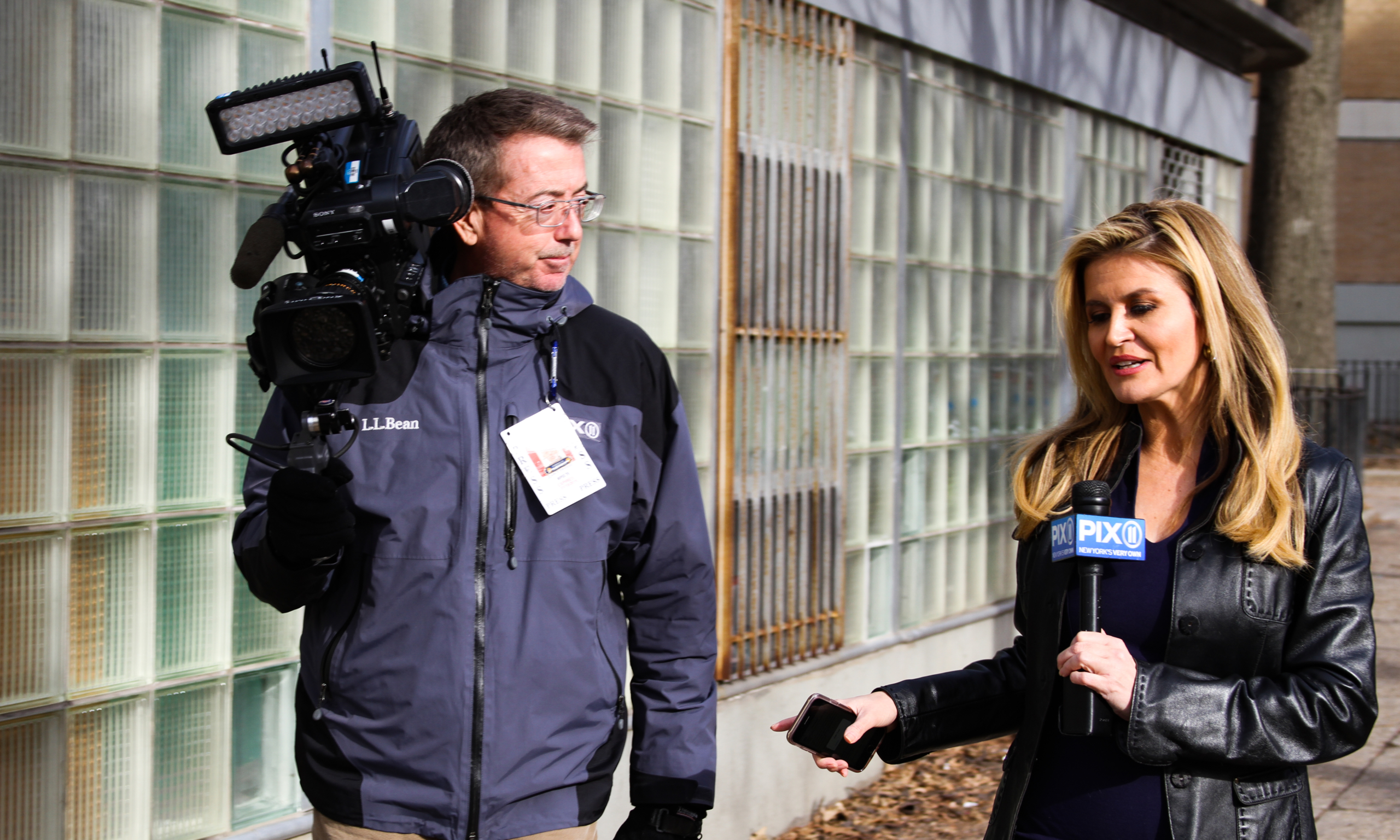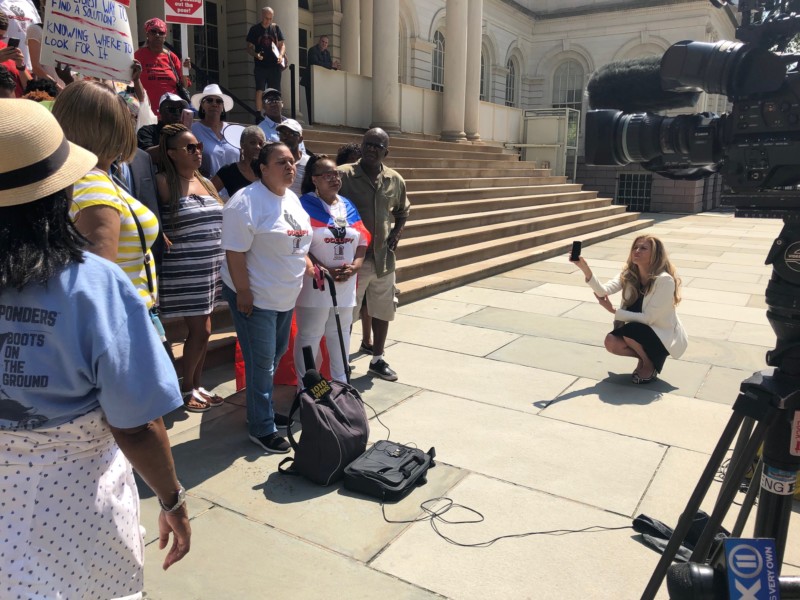Monica Morales, a reporter for PIX11, had never heard of the eighties hip-hop and funk band ESG (emerald, sapphire, and gold) when she visited Debbie Scroggins’s apartment. Scroggins, ESG’s original bassist, lives at the Farragut Houses, a public complex in Brooklyn. She had sent Morales cell phone photos of rot beneath her toilet and moisture on her kitchen walls—“sweat,” she called it.
Morales came on a gray afternoon in late spring. Scroggins hoped the press would inspire staff from New York City’s beleaguered housing authority to make overdue repairs. During a break between takes, Morales, who is 44 with wavy blonde hair, pulled out her iPhone, in a gold case. At Scroggins’s suggestion, she googled an ESG instrumental track, “UFO,” which has been sampled by the Beastie Boys, N.W.A., and the Notorious B.I.G., among others. Scroggins pointed out her bass line. “You’re going to hear that weow, weow,” she said. “That bar right there.”
“That’s the name of the song? UFO?” Morales said. “I was going to say, it does sound like a UFO!” Then the camera started rolling again, and she got her story.
“Monica Makes it Happen,” Morales’s franchise, launched in May 2016 as a recurring segment: problem identified, problem fixed. “Brooklyn Students Need Your Help to Save Prom,” the first headline read. But it wasn’t until January 2018 that a story about heat and hot water outages at the Redfern Houses in Far Rockaway, Queens, made her the foremost chronicler of the city’s public housing conditions. “The calls and emails kept coming in,” Amy Waldman, PIX11’s former news director, recalls. “This story affected entire communities in our area and that became evident. So we felt that we had to stay on it.”
To watch Morales on TV and social media for the past year-and-half-plus has been to enter, almost daily, the courtyards, hallways, kitchens, and bedrooms of more than 100 residential complexes maintained by the New York City Housing Authority. The largest public housing agency in the country, with more than 400,000 residents, NYCHA is more than $32 billion in debt and under federal scrutiny for its mismanagement, a staggering backlog of repair requests, and the precipitation of a lead paint crisis. Morales is the only reporter in New York to make covering public housing a full-time beat, reporting from city-owned complexes nearly every day of the week. She’s an anomaly nationally, too.
“I don’t know of any other reporter in the country who is being given those kinds of resources for that type of beat,” Larry Stuelpnagel, a TV news veteran and broadcast professor at the Medill School of Journalism, says. Reporters in Illinois, Ohio, Texas, Pennsylvania, and Atlanta cover public and subsidized housing, but no one I spoke to focuses on the beat full-time. “If I can get buy-in from my bosses on an investigative story that addresses a systemic issue and holds people in power accountable, I can do the story,” Willoughby Mariano, an investigative reporter with the Atlanta Journal Constitution, says. “But that’s a much higher bar than what existed in the past for affordable housing.”
Last year, Molly Parker, a reporter with The Southern Illinoisan, collaborated with ProPublica to report on the United States Department of Housing and Urban Development. She’s an admirer of Morales’s stories. “I watch them all,” she says. Systemic change can feel elusive when reporting on public housing, but when it comes to Morales’s small success stories, “to the person who got [something] fixed, there is no greater story that could be told.”
Errol Louis, host of Inside City Hall on NY1, says that Morales filled a void. “A big part of what was missing until recently was a general, broad public understanding of just how bad conditions were,” he explains. “And there’s no better way to inform people than to bring a camera to the place and letting them see for themselves.”
While out reporting, Morales takes interludes on Facebook Live, squinting and smiling at her phone’s camera and occasionally greeting her viewers by name. Her social media feeds reflect the singular focus of her coverage and amplify residents’ pleas for help, broadcasting their photos and videos of leaks and mold to thousands of followers, including employees of city and state agencies. “As soon as I tweet something I get an immediate, ‘Are you doing this story today?’” from NYCHA’s press team, she says.
Last fall, Viviana Wrenn, a 28-year-old mother from the Stebbins Avenue-Hewitt Place Houses, in the Bronx, had no heat in her apartment. Her husband suggested that she contact Morales. “He said, ‘Find Monica Morales and reach out to her. She gets it done,’” Wrenn recalls. “So while I had him on the phone I opened up Twitter, I found Monica, and I started tweeting her. She responded within five minutes.”
In conversation, Morales is warm and speaks with a sense of urgency. Originally from Miami, she started her TV journalism career with frequent “market jumping,” from Atlanta to Milwaukee to Miami to Boston to New York. “I think with television journalism especially, it can be so—I hate to say it—just, surface,” she explains. “Just, here’s what happened, and then we leave. And I was always frustrated by that. Even when I covered fires and I covered shootings. It was, like, what happens to the families?”
With her NYCHA coverage, Morales quantifies her results: 40 bathrooms, living rooms, and bedrooms repaired; heat and hot water restored to more than 55 buildings; six families transferred out of hazardous apartments. In weekly “Follow up Friday” segments, she returns to an apartment to celebrate speedy repairs, signalling that positive results are routine. (Friendly press is part of Morales’s strategy to build trust with the city. “They know that if they fix it, I will go back and I will show it fixed,” she explains.)
Morales describes feeling a personal connection to her subjects. Her mother, Maria Teresa Morales, immigrated to the US from Bolivia as a teenager, and was undocumented before she married Morales’s father, a first-generation immigrant from Norway. Maria Teresa washed hair for Elizabeth Arden and worked as a home health aide before becoming a housewife. Morales, who now has two young children of her own, remembers watching her mother struggle. “My father was an active alcoholic. The bottom line is, she was the boss of my family and I think it was hard for her,” she says. “I’m fighting for someone like my mom.”
PIX11 has made Morales’s work a part of its identity. On Facebook, the station targets her stories to zip codes with significant NYCHA populations. A 2018 PIX11 ad campaign in 500 buses and 50 bus shelters featured a woman wearing a face mask scrawled with the words “NYCHA IS MAKING ME SICK” in bold letters, alongside the station’s slogan: “Your Fight is Our Fight.”
Last year, the station converted a conference room into a studio dubbed the Social Media Center for recurring segments, including a weekly Facebook Live show in which Morales features NYCHA residents and tenant association leaders, as well as housing lawyers, city and state legislators, and the director of HUD. This year, the Social Media Center won an Emmy in the “Interactivity” category
Yet nearly two years after Morales dedicated herself to public housing, she says the work can sometimes feel futile. “A lot of the things we have fixed, we have to go back,” she says. “There are a lot of bathrooms that are now back with mold. It’s very frustrating because it’s a game of whack-a-mole.”
Her approach has its critics. Manny Martinez is a tenant leader from the South Jamaica Houses, in Queens, and a lead organizer with the Occupy NYCHA campaign, a new group working in opposition to Mayor Bill de Blasio’s plan to greatly expand private management of NYCHA. He wants to fight for resident control, and says a steady stream of footage of decrepit apartments enforces stereotypes about public housing. “That becomes the trend and that also becomes the ratings,” Martinez said at an Occupy NYCHA rally at City Hall in August. He recalled a recent conversation with someone who was skeptical of his pitch that NYCHA residents should own their homes: “He said, ‘Home ownership? Why would you want to own that?’”
Then again, Martinez told me later, Morales was the only television reporter to bring a camera to the press conference that day.
In April, City Hall reporters spoofed Morales at the annual Inner Circle show, a satirical review that raises money for charity by targeting politicians, city agencies, and reporters with original skits and songs. Morales was portrayed by another journalist—with a blonde wig, iPhone, and all. “If you missed this edition of Facebook Live I’ll be back every five minutes forever!” the Morales character said. Morales was upset at first. “I said, ‘Listen girl,’” her friend Carmen Quinones, a NYCHA tenant leader in Manhattan, recalls. “As long as they’re talking about you, you’re important.’”
After the Scroggins segment aired, NYCHA management installed new cabinets in her kitchen, she says, and fixed a leak in the bathroom. There are new leaks now, and a roach problem, but Morales gave Scroggins her number and she plans to follow up. “I really appreciate that very much because a lot of media people are in their own world and they don’t like to come down to earth here,” Scroggins says. “They get their story and that’s it.”
Leaving Scroggins’s apartment, Morales was reflective. “There are a lot of haters out there,” she told me. “They’re like, ‘Really? You’re just fixing a sink today?’ Or, ‘You’re getting a stove for a mom?’”
Then a woman approached: Sandra Bradford, another Farragut tenant, who pulled out her phone to show Morales photos of a rat infestation inside her apartment. The two women exchanged numbers, and Bradford thanked Morales for her housing coverage. “Even just seeing it on the news is a comfort to me. You have no idea,” Bradford said. “You give somebody like me a voice that’s heard.”
Editors note: This story has been updated to specify Amy Waldman’s title, information about PIX11’s social media programming, and a detail about the station’s Emmy win.
Emma Whitford is a reporter based in Brooklyn. Recently, her writing has appeared in the New York Daily News, TIME, and the Queens Daily Eagle. Follow her on Twitter @emma_a_whitford.



